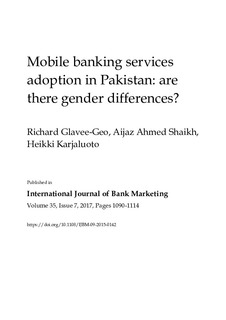| dc.contributor.author | Glavee-Geo, Richard | |
| dc.contributor.author | Shaikh, Aijaz Ahmed | |
| dc.contributor.author | Karjaluoto, Heikki | |
| dc.date.accessioned | 2018-03-26T10:46:27Z | |
| dc.date.available | 2018-03-26T10:46:27Z | |
| dc.date.created | 2017-09-21T22:54:24Z | |
| dc.date.issued | 2017 | |
| dc.identifier.citation | International Journal of Bank Marketing. 2017, 35 (7), 1090-1114. | nb_NO |
| dc.identifier.issn | 0265-2323 | |
| dc.identifier.uri | http://hdl.handle.net/11250/2492080 | |
| dc.description.abstract | Purpose
The purpose of this paper is to provide a comprehensive insight into the deciding factors affecting an individual’s intention to adopt mobile banking (m-banking) services in Pakistan.
Design/methodology/approach
A survey approach was used with a sample of 189 responses from across Pakistan. Multi-group analysis was performed in order to detect gender differences among men and women in the process of adopting m-banking.
Findings
The paper found support for the positive effect of perceived behavioral control (PBC) and attitudes (ATT) toward m-banking adoption intentions. Significant differences between men and women were found to affect subjective norms (SN) on adoption intention, even though the combined sample of men and women was insignificant. The effect of SN on m-banking adoption is stronger for women than for men. Interestingly, the paper provides contradictory findings on the role of PBC on adoption intention. The effect of PBC on m-banking adoption intention was found to be significantly stronger for men than for women.
Practical implications
The results present implications of consumer behavior and marketing communication for bank marketing. Although men and women do not differ in their ATT toward m-banking service adoption in general, the succinct nuance between men and women in terms of the influence of SN and PBC with adoption intention calls for a strategic reorientation of how men and women as consumers of m-banking services should be appropriately segmented, targeted and communicated. The formulation of marketing strategies to target potential consumers and to reinforce the usefulness of m-banking to existing consumers should not be “one size fits all.” The marketing of m-banking services to segments of men and women should be approached strategically in order to increase adoption rates in developing/emerging economies.
Originality/value
This is the first study on m-banking services adoption in Pakistan to examine the role of gender in the innovation adoption process. The differences between the two genders and the insightful results that we found in our study help shed light on the uniqueness of the context. This study is also one of the first to test a combined technology acceptance model and theory of planned behavior model in the context of m-banking adoption in a developing country using a variance-based modeling technique. | nb_NO |
| dc.language.iso | eng | nb_NO |
| dc.publisher | Emerald | nb_NO |
| dc.title | Mobile banking services adoption in Pakistan: are there gender differences? | nb_NO |
| dc.type | Journal article | nb_NO |
| dc.type | Peer reviewed | nb_NO |
| dc.description.version | acceptedVersion | nb_NO |
| dc.source.pagenumber | 1090-1114 | nb_NO |
| dc.source.volume | 35 | nb_NO |
| dc.source.journal | International Journal of Bank Marketing | nb_NO |
| dc.source.issue | 7 | nb_NO |
| dc.identifier.doi | 10.1108/IJBM-09-2015-0142 | |
| dc.identifier.cristin | 1496750 | |
| dc.description.localcode | © 2017. This is the authors' accepted and refereed manuscript to the article. The final authenticated version is available online at: https://www.emeraldinsight.com/doi/full/10.1108/IJBM-09-2015-0142 | nb_NO |
| cristin.unitcode | 194,60,15,0 | |
| cristin.unitname | Institutt for internasjonal forretningsdrift | |
| cristin.ispublished | true | |
| cristin.fulltext | postprint | |
| cristin.qualitycode | 1 | |
